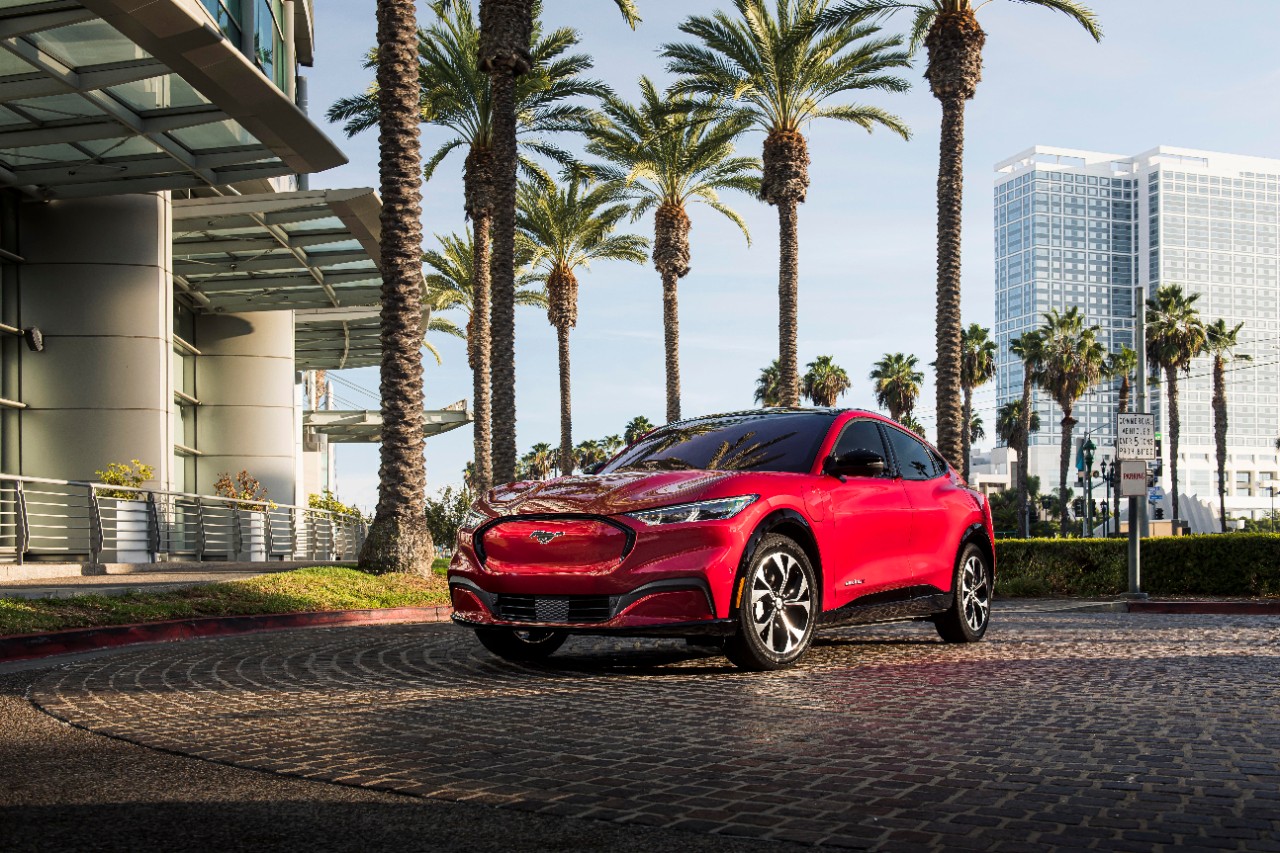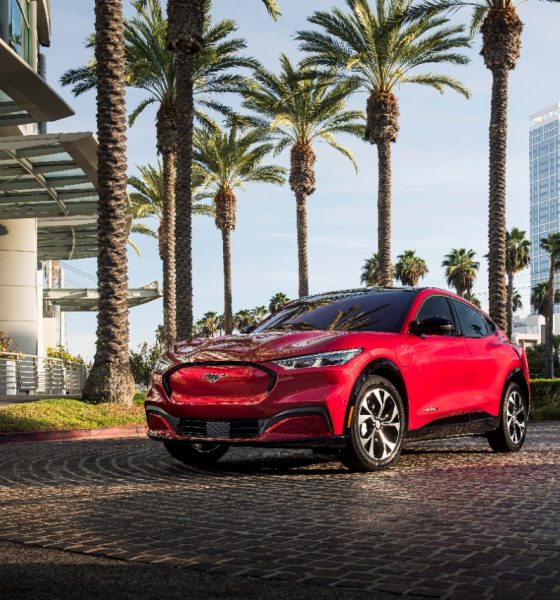Ford announced this morning that it was slashing prices of all trims of its Ford Mustang Mach-E, while dramatically increasing production.
Tesla’s aggressive price cut at the beginning of this month has caused massive waves within the automotive industry and the car market, as competitors and car sellers alike are forced to battle with the aggressive new pricing. Now, Ford has done just that by rapidly increasing production of its popular Mustang Mach-E EV SUV and subsequently slashing prices.
According to Ford’s press release this morning, the Ford Mustang Mach-E’s price will be cut by as much as $5,900 on the top trim model and $900 off the base model vehicle. Ford did not specify the scale of the upcoming production increase. However, the company noted that it “has secured the batteries and raw material to scale production of [electric vehicles] in 2023.”
| 2023 Mustang Mach-E
|
Former MSRP
|
Updated MSRP
|
Delta
|
||
| Select RWD Standard Range
Select eAWD Standard Range California Route 1 eAWD Extended Range Premium RWD Standard Range Premium eAWD Standard Range GT Extended Range |
$ 46,895
$ 49,595 $ 63,575 $ 54,975 $ 57,675 $ 69,895 |
$45,995
$48,995 $57,995 $50,995 $53,995 $63,995 |
$ 900
$ 600 $5,580 $3,980 $3,680 $5,900 |
||
| Extended Range Battery
Nite Pony Appearance Package GT Performance Package |
$ 8,600
$ 800 $ 6,000 |
$7,000
$ 800 $6,000 |
$1,600
$ 0 $ 0 |
Ford did not specify if a price cut would come to the company’s other incredibly popular EV offerings, including the Ford F-150 Lightning and the E Transit. Still, with production increases already underway for both models, a similar price cut could be possible in the near future. This is only compounded by the fact that Ford is closer than ever to securing its own battery supply through its partnership with SK ON. This partnership could result in reduced battery and (ultimately) vehicle costs.
“We are not going to cede ground to anyone. We are producing more EVs to reduce customer wait times, offering competitive pricing, and working to create an ownership experience that is second to none,” said Marin Gjaja, Chief Customer Officer of Ford Model e. “Our customers are at the center of everything we do – as we continue to build thrilling and exciting electric vehicles, we will continue to push the boundaries to make EVs more accessible for everybody.”
Ford CEO Jim Farley had similarly positive comments on the price cut, noting the goal of making EVs “more accessible.”
At @Ford, we want to make EVs more accessible, so we’re increasing #MustangMachE production & reducing prices across the Mach-E lineup. Scaling will shorten customer wait times. And with higher production, we’re reducing costs, which allows us share these savings with customers.
— Jim Farley (@jimfarley98) January 30, 2023
While this aggressive price cut is great news for consumers and fantastic news for the EV market that looks to overtake gas vehicle sales as soon as possible, perhaps current owners will be most affected by the price cut.
The best example of this externality is already on display in the used Tesla market, where current sellers have found their vehicles undercut by cheaper new offerings from Tesla. This price bubble was bound to burst sometime or another, and sellers have been caught unprepared and may be forced to take a rare loss on their Tesla vehicle.
Looking at Ford Mustang Mach-Es currently on the market, sellers are in for a similarly rude awakening. Some Mach-Es are currently on the used market for as much as $10,000 over sticker, with the average used Mach-E only price equivalent to the new price set by Ford.
As EVs continue to decrease in price over the next couple of months and years, no doubt used EVs will follow as competitive manufacturer prices force the market downward. Hopefully, these combined factors will mean that more and more people can get into electric vehicles sooner than previously anticipated.
What do you think of the article? Do you have any comments, questions, or concerns? Shoot me an email at william@teslarati.com. You can also reach me on Twitter @WilliamWritin. If you have news tips, email us at tips@teslarati.com!

Elon Musk
Elon Musk’s X will start using a Tesla-like software update strategy
The initiative seems designed to accelerate updates to the social media platform, while maintaining maximum transparency.

Elon Musk’s social media platform X will adopt a Tesla-esque approach to software updates for its algorithm.
The initiative seems designed to accelerate updates to the social media platform, while maintaining maximum transparency.
X’s updates to its updates
As per Musk in a post on X, the social media company will be making a new algorithm to determine what organic and advertising posts are recommended to users. These updates would then be repeated every four weeks.
“We will make the new 𝕏 algorithm, including all code used to determine what organic and advertising posts are recommended to users, open source in 7 days. This will be repeated every 4 weeks, with comprehensive developer notes, to help you understand what changed,” Musk wrote in his post.
The initiative somewhat mirrors Tesla’s over-the-air update model, where vehicle software is regularly refined and pushed to users with detailed release notes. This should allow users to better understand the details of X’s every update and foster a healthy feedback loop for the social media platform.
xAI and X
X, formerly Twitter, has been acquired by Elon Musk’s artificial intelligence startup, xAI last year. Since then, xAI has seen a rapid rise in valuation. Following the company’s the company’s upsized $20 billion Series E funding round, estimates now suggest that xAI is worth tens about $230 to $235 billion. That’s several times larger than Tesla when Elon Musk received his controversial 2018 CEO Performance Award.
As per xAI, the Series E funding round attracted a diverse group of investors, including Valor Equity Partners, Stepstone Group, Fidelity Management & Research Company, Qatar Investment Authority, MGX, and Baron Capital Group, among others. Strategic partners NVIDIA and Cisco Investments also continued support for building the world’s largest GPU clusters.
News
Tesla FSD Supervised wins MotorTrend’s Best Driver Assistance Award
The decision marks a notable reversal for the publication from prior years, with judges citing major real-world improvements that pushed Tesla’s latest FSD software ahead of every competing ADAS system.

Tesla’s Full Self-Driving (Supervised) system has been named the best driver-assistance technology on the market, earning top honors at the 2026 MotorTrend Best Tech Awards.
The decision marks a notable reversal for the publication from prior years, with judges citing major real-world improvements that pushed Tesla’s latest FSD software ahead of every competing ADAS system. And it wasn’t even close.
MotorTrend reverses course
MotorTrend awarded Tesla FSD (Supervised) its 2026 Best Tech Driver Assistance title after extensive testing of the latest v14 software. The publication acknowledged that it had previously criticized earlier versions of FSD for erratic behavior and near-miss incidents, ultimately favoring rivals such as GM’s Super Cruise in earlier evaluations.
According to MotorTrend, the newest iteration of FSD resolved many of those shortcomings. Testers said v14 showed far smoother behavior in complex urban scenarios, including unprotected left turns, traffic circles, emergency vehicles, and dense city streets. While the system still requires constant driver supervision, judges concluded that no other advanced driver-assistance system currently matches its breadth of capability.
Unlike rival systems that rely on combinations of cameras, radar, lidar, and mapped highways, Tesla’s FSD operates using a camera-only approach and is capable of driving on city streets, rural roads, and freeways. MotorTrend stated that pure utility, the ability to handle nearly all road types, ultimately separated FSD from competitors like Ford BlueCruise, GM Super Cruise, and BMW’s Highway Assistant.
High cost and high capability
MotorTrend also addressed FSD’s pricing, which remains significantly higher than rival systems. Tesla currently charges $8,000 for a one-time purchase or $99 per month for a subscription, compared with far lower upfront and subscription costs from other automakers. The publication noted that the premium is justified given FSD’s unmatched scope and continuous software evolution.
Safety remained a central focus of the evaluation. While testers reported collision-free operation over thousands of miles, they noted ongoing concerns around FSD’s configurable driving modes, including options that allow aggressive driving and speeds beyond posted limits. MotorTrend emphasized that, like all Level 2 systems, FSD still depends on a fully attentive human driver at all times.
Despite those caveats, the publication concluded that Tesla’s rapid software progress fundamentally reshaped the competitive landscape. For drivers seeking the most capable hands-on driver-assistance system available today, MotorTrend concluded Tesla FSD (Supervised) now stands alone at the top.
News
Elon Musk’s Grokipedia surges to 5.6M articles, almost 79% of English Wikipedia
The explosive growth marks a major milestone for the AI-powered online encyclopedia, which was launched by Elon Musk’s xAI just months ago.

Elon Musk’s Grokipedia has grown to an impressive 5,615,201 articles as of today, closing in on 79% of the English Wikipedia’s current total of 7,119,376 articles.
The explosive growth marks a major milestone for the AI-powered online encyclopedia, which was launched by Elon Musk’s xAI just months ago. Needless to say, it would only be a matter of time before Grokipedia exceeds English Wikipedia in sheer volume.
Grokipedia’s rapid growth
xAI’s vision for Grokipedia emphasizes neutrality, while Grok’s reasoning capabilities allow for fast drafting and fact-checking. When Elon Musk announced the initiative in late September 2025, he noted that Grokipedia would be an improvement to Wikipedia because it would be designed to avoid bias.
At the time, Musk noted that Grokipedia “is a necessary step towards the xAI goal of understanding the Universe.”
Grokipedia was launched in late October, and while xAI was careful to list it only as Version 0.1 at the time, the online encyclopedia immediately earned praise. Wikipedia co-founder Larry Sanger highlighted the project’s innovative approach, noting how it leverages AI to fill knowledge gaps and enable rapid updates. Netizens also observed how Grokipedia tends to present articles in a more objective manner compared to Wikipedia, which is edited by humans.
Elon Musk’s ambitious plans
With 5,615,201 total articles, Grokipedia has now grown to almost 79% of English Wikipedia’s article base. This is incredibly quick, though Grokipedia remains text-only for now. xAI, for its part, has now updated the online encyclopedia’s iteration to v0.2.
Elon Musk has shared bold ideas for Grokipedia, including sending a record of the entire knowledge base to space as part of xAI’s mission to preserve and expand human understanding. At some point, Musk stated that Grokipedia will be renamed to Encyclopedia Galactica, and it will be sent to the cosmos.
“When Grokipedia is good enough (long way to go), we will change the name to Encyclopedia Galactica. It will be an open source distillation of all knowledge, including audio, images and video. Join xAI to help build the sci-fi version of the Library of Alexandria!” Musk wrote, adding in a later post that “Copies will be etched in stone and sent to the Moon, Mars and beyond. This time, it will not be lost.”










